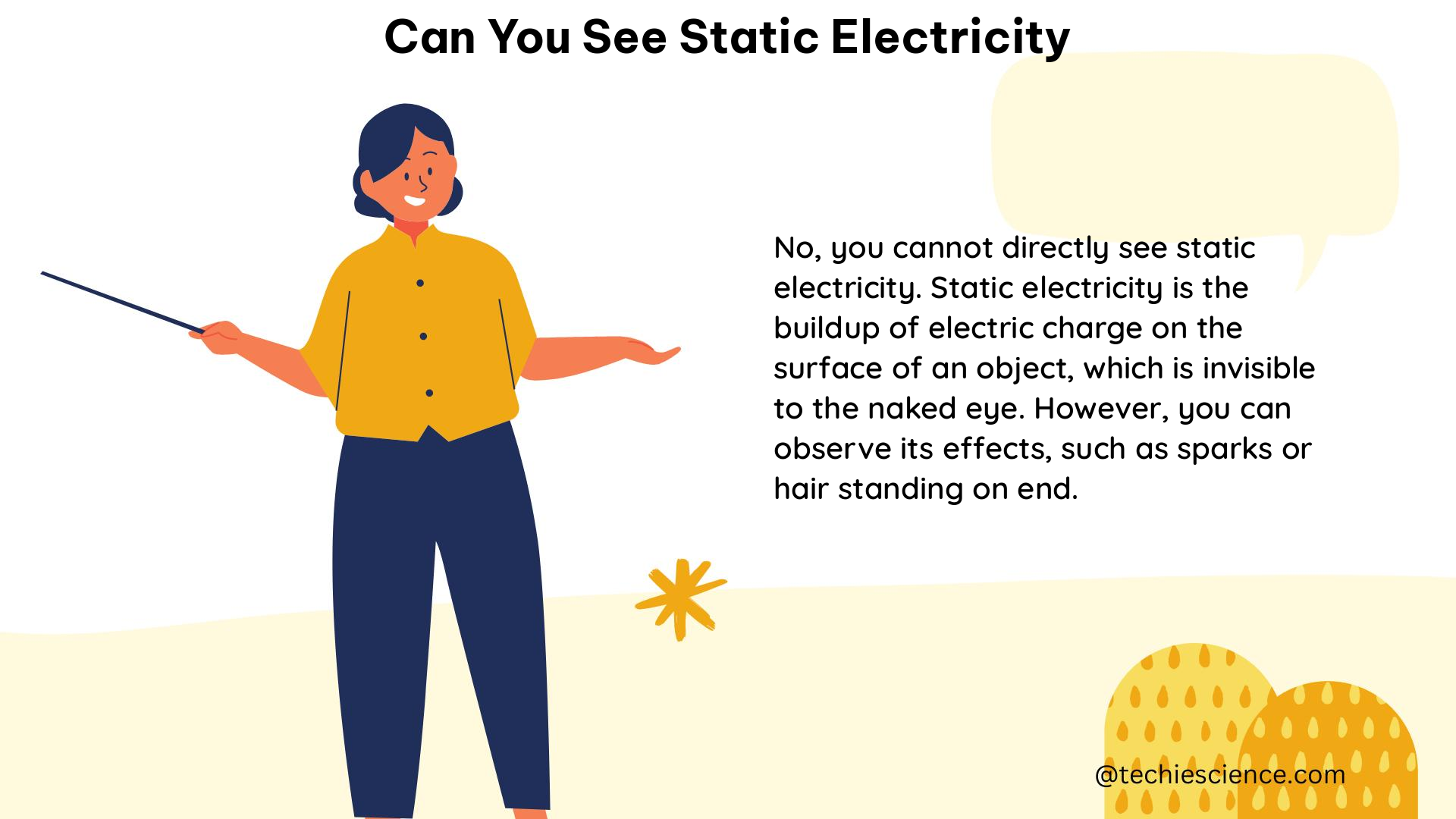Summary
Static electricity is a buildup of electric charge on the surface of a material, which can be either positive or negative and is generated through various means. While it is not possible to directly see the charge itself, the effects of static electricity can be observed through various methods, including electrostatic induction, instrumental measurement, and triboluminescence. This article provides a comprehensive guide on understanding and observing static electricity, with detailed information on relevant theorems, physics formulas, examples, numerical problems, figures, data points, values, and measurements.
Understanding the Nature of Static Electricity

Theorem: Electric Charge
Electric charge is a fundamental property of matter, measured in Coulombs (C). It can be either positive or negative, and it is the source of all electromagnetic phenomena, including static electricity.
Physics Formula: Charge, Capacitance, and Voltage
The relationship between charge (Q), capacitance (C), and voltage (V) is given by the formula:
Q = C × V
This formula is crucial for understanding and measuring static electricity, as it allows us to determine the amount of charge present based on the voltage and capacitance of the system.
Physics Example: Balloon and Sweater
When a balloon is rubbed on a sweater, it can gain a charge of several thousand volts. This charge can cause the balloon to stick to a wall due to the phenomenon of electrostatic induction, where the charged balloon induces an opposite charge in the neutral wall, resulting in an attractive force.
Physics Numerical Problem: Capacitor Charge
If a capacitor has a capacitance of 100 pF and is charged to a voltage of 1000 V, what is the charge on the capacitor?
Solution:
Q = C × V
Q = 100 pF × 1000 V
Q = 0.01 C
Observing the Effects of Static Electricity
Electrostatic Induction
When a charged object is brought close to a neutral object, it can induce a charge in the neutral object, causing it to be attracted or repelled by the charged object. This phenomenon is known as electrostatic induction and can be observed in everyday situations, such as when a balloon is rubbed on a sweater and then stuck to a wall.
Instrumental Measurement
Specialized instruments, such as electrostatic fieldmeters or static voltage probes, can be used to measure the electric field or surface voltage related to static electricity. These measurements can provide insight into the size and location of the static charge.
Data Point: Fraser 715 Static Meter
The Fraser 715 Static Meter, mentioned in the sources, can measure surface voltage up to 20 kV using a capacitor-based circuit. By setting the capacitance at a fixed measuring distance, the charge Q can be measured directly in terms of voltage V.
Triboluminescence
Triboluminescence is the emission of light caused by the breaking of chemical bonds in a material, and it can be triggered by various means, including friction or impact. In the context of static electricity, triboluminescence can occur when a charged object is rubbed against a material, causing the material to emit a faint glow.
Figure: Relationship between Electric Field Strength and Voltage
The sources provide a graph showing the relationship between electric field strength and voltage, which can be useful for understanding the magnitude of static electricity and its potential effects.
Measurement Considerations
Value: Electric Field Strength Range
The electric field strength of static electricity can range from a few volts per meter to several thousand volts per meter, depending on the strength of the charge.
Measurement: Specialized Instruments
The measurement of static electricity typically involves the use of specialized instruments, such as electrostatic fieldmeters or static voltage probes, which can measure the electric field or surface voltage related to the static charge.
Conclusion
While it is not possible to directly see static electricity, its effects can be observed through various means, including electrostatic induction, instrumental measurement, and triboluminescence. Understanding the nature of static electricity and the methods for observing its effects can provide valuable insights and inform strategies for managing and mitigating its impact in various applications.
References
- Measuring and using static electricity, Test and Measurement Tips, https://www.testandmeasurementtips.com/measuring-and-using-static-electricity-faq/
- Static electricity: quantitative measurement & prevention, VEX Forum, https://www.vexforum.com/t/static-electricity-quantitative-measurement-prevention/96410
- Measurement of Static Electricity, Fraser Anti-Static Techniques, https://fraser-antistatic.com/knowledge-centre/insights/measurement-of-static-electricity/
- Can you see static electricity? : r/NoStupidQuestions – Reddit, https://www.reddit.com/r/NoStupidQuestions/comments/t04qvq/can_you_see_static_electricity/
- Measuring Surface Resistance For the temporary electrostatic adhesion of two materials to be effective, at least one of the materials must be a good insulator, Fraser Anti-Static Techniques, https://fraser-antistatic.com/knowledge-centre/insights/measuring-surface-resistance/
Hi…..I am Harshitha H N. I have completed my master’s in Physics from the University of Mysore with a specialization in Nuclear physics. I enjoy exploring new things in my free time. My article always aims to develop and bring some value to the table with relevant topics.
Let’s connect through LinkedIn-